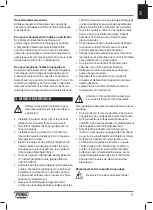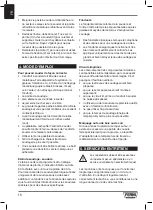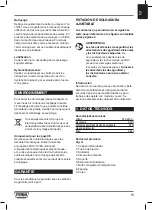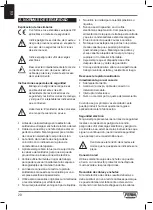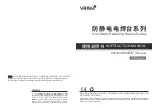
5
EN
Below, we give you some examples of poorly
soldered joints:
• If the soldering tin is tear-shaped, the soldering
coagulate was too cold.
• If the soldering tin is dull and slightly porous
or crystalline, the parts were probably moved
during the cooling process.
• If too little soldering tin has been left in the
joint, the soldering was too warm or the
soldering tin was not melted sufficiently.
• If the soldering tin is yellow or black, this
means that too much soldering paste has been
used or that the inner core of the tin solder wire
has become overheated during soldering. You
must avoid this above all in electronic circuits
since most acid pastes are corrosive and
reduce the service life of electronic wiring.
Replacement of the soldering tip
Pull out the mains plug!
• Switch off the soldering station and disconnect
from the mains. Let the soldering iron and
tip cool down to room temperature before
handling.
• Unscrew the fixing nut (2). Pull out the tip (1)
from the soldering iron (3) and remove any
oxide that may have formed on the barrel. Be
careful to avoid getting dust in your eyes.
• Replace the tip (1) with another tip and screw
the fixing nut (2) assembly onto the iron (3)
using only hand pressure to tighten. Do not
apply excessive pressure to avoid damage.
4. WORKING INDICATIONS
For good soldering
• The soldering joint must be reguline. Remove
oxidation, grease and so forth by means of
mechanical (abrasive paper, brushes, file) or
chemical cleaners (alcohol, fluxing agent).
• The soldering tip
• Give a good plating of soldering tin.
• Never work on it with a file.
• Pretinplating of the parts which are to be
tinplated makes the soldering easier and
ensures a perfect electrical contact.
• Ensure that the wires are mechanically
connected before soldering (twist together,
hook into place, attach round eyelets).
• First heat up the soldering joint and then melt
the solder over the soldering joint and allow it
to flow in.
• Melt as little solder as possible.
• Keep the heat load (soldering time) as short as
possible.
• A perfect soldering joint is shiny and smooth.
The edge shows a clean, bonding join to the
metal.
Soldering tin solder
Soldering tin is essentially an alloy of tin and lead.
The designation of 60/40 means a combination of
60% tin with 40% lead. For electrically soldered
joints, use only non-acid solder and fluxing agent.
For information on special solder for specific
work, consult the manufacturer.
Flux
The melting of the solder is improved with the use
of flux while, at the same time, impurities such as
grease or metal oxide are removed and evaporate
during soldering.
• Organic fluxing agents like colophonium and
resins for acid-free soldering.
• Inorganic fluxing agents, which are highly
effective these are effective but corrosive.
Use only for larger joints and clean the soldering
joint thoroughly afterwards.
Printed circuits
The strip conductors and the miniature
component parts are very temperature-sensitive
and can therefore be easily damaged. Pay
attention to the following:
• Prepare the soldering work well.
• Pre-assemble the component parts.
• Secure the printed circuit board or soldering
joint against shifts.
• Use only first class solder with anticorrosive
flux.
• Do not apply any surplus solder.
• Keep the soldering time (heat load) as short as
possible.
Содержание SGM1013
Страница 2: ...2 Fig B 4 1 2 3 5 6 7 8 9...
Страница 67: ...67 EL 2 CE H H...
Страница 68: ...68 EL N 1 5 mm2 3 5 3 8 1 4 7 160 C 500 C 10...
Страница 69: ...69 EL 2 1 3 1 2 3 4 E 60 40 60 40...
Страница 70: ...70 EL 5 o 2012 19 EU...
Страница 71: ...71 MK 2 1 220 240 V 50 Hz 48 W I 0 6 kg A 1 2 3 4 5 6 7 8 9 2...
Страница 72: ...72 MK 1 5 mm2 3 5 3 8 1 4 7 160 C 500 C...
Страница 73: ...73 MK 10 2 1 3 1 2 3 4 60 40 60 40...
Страница 74: ...74 MK 5 2012 19 EU...
Страница 75: ...75...
Страница 77: ...77...
Страница 78: ...78...
Страница 80: ...WWW FERM COM 2018 FERM B V 1801 03...

















